|
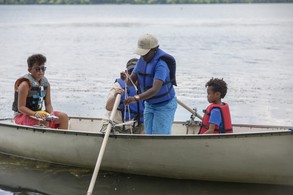
The monitoring season is winding down and there’s just one week left to take clarity readings on your lake or stream. After that, yet another Secchi season comes to a close!
As always, we are so thankful for your dedication to lakes and streams in Minnesota. Your knowledge and engagement plays such an important role in protecting lakes and streams and the MPCA is grateful for all you do.
We look forward to receiving your 2019 Secchi data and ask that you please send it to us by October 31st, if possible. This gives us the time needed to enter it into our database and prepare it for display through our online reporting system.
As a reminder, you can submit your data to us electronically using our Microsoft Excel template. Download the file to your computer, fill it in with your data, attach it to an email addressed to us, and you're done! If you submit your data electronically, you can keep your paper datasheet for your records. Important Note: DO NOT reply to this newsletter email with your 2019 Secchi data. The CMP DOES NOT receive any replies through the newsletter delivery system. Please send a separate email to us at the addresses listed below with your 2019 data.
You can download both the Lake and Stream Excel Electronic Datasheets from the Resources for Volunteers page on our website.
Back to top
|

The 2019 Citizen Monitoring Program (CMP) Secchi Social is less than a week away! It will be held at at the University of Minnesota in Morris on Wednesday September 25th. Coffee and sign-in starts at 10:00am. The program begins at 11:00am and runs through 2:00pm.
We have pulled together an exciting group of speakers, food, and activities for you, and we hope that you will join us for a fun day of sharing information, stories, and getting to know one another! Here is a glimpse of what we have planned for the day:
- Panel Q&A with local water quality experts, ready to answer your most pressing water quality questions.
- Citizen Monitoring Program volunteers will share their thoughts & perspectives on their monitoring experience
- Special recognition of 5-year “Milestone” volunteers in attendance
- Raffle prizes, including Fishing, Camping, and Hiking Gift Packs, and 2 State Park Annual passes
- Green tour of U of M Morris campus
If you would like to attend, please contact Laurie or Shannon directly at 651-757-2750 or 651-757-2874. There is no cost, and each volunteer can have one additional guest attend.
Back to top
|
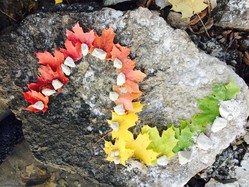
This past spring, the University of Minnesota helped the CMP conduct a survey on how to best engage people in science-based volunteer opportunities, such as the MPCA's Citizen Water Monitoring Programs. An astonishing 662 of you took the survey - a participation rate that just blew us away! We really appreciate you taking the time to provide this valuable feedback to us! Here's a brief summary of the results:
- Personal networks such as family, friends and neighbors are key for sharing and receiving information, not only about the program, but about lake and stream health in general.
- Preserving a deep connection with a particular lake or stream, sharing that and continuing to pass that along to future generations is of deep importance to volunteers.
- The program needs a technology upgrade, especially in terms of methods for reporting data online and via mobile apps.
- More access to webinars, podcasts and advanced water monitoring opportunities is desired.
- More feedback on how CMP data are used by decision makers, in addition to how waterbodies compare with one another is desired.
- Mobility issues, lack of resources and lack of transportation are the main barriers to participating in the program.
- Our newsletter publication is highly valued, which is great to know! We'll keep including as many interesting and applicable topics as we can.
We received such detailed comments and feedback from so many of you. Please know, they WILL be used to help our programs grow and thrive.
If you have any questions about the survey process or results, please don't hesitate to contact us.
Back to top
|

In 2016, the CMP launched into the world of social media by joining Facebook and Twitter. These platforms have allowed us to promote and share program information, and reach new audiences. However, it didn't help us create a community space for information sharing between volunteers as we had hoped - enter the CMP's new Facebook group!
You can find and join this newly created group by searching for "MPCA Citizen Water Monitors" and clicking the "Join" button.
The MPCA Citizen Water Monitors group is public and intended to serve as a space for Citizen Lake and Stream Water Monitors to share water monitoring experiences, ask questions and build a community network. Views posted by group members will be considered their own and not condoned or advocated by the MPCA. The MPCA will, however, strive to maintain a group space that is welcoming, positive and free from harassment.
We look forward to the conversations this new forum will spark! Please let us know if you have any questions about participating.
Back to top
|

The 2018 issue of the Citizen Monitoring Program’s annual yearbook, Reflections, is now available. We are presenting Reflections as a slideshow for the first time this year to reduce printing costs and resource use, while exploring new ways to share your monitoring stories.
You can access the Reflections slideshow on YouTube at: https://youtu.be/E_84KTzDqrI The slides advance automatically, but if you need more time to read any of the stories, you can pause the slideshow at any time. We hope you enjoy the collection of images and stories shared by your fellow water monitors!
Back to top
|

The Minnesota Agricultural Water Quality Certification Program (MAWQCP) is a voluntary opportunity for farmers and agricultural landowners to take the lead in implementing conservation practices that protect water. Those who implement and maintain approved farm management practices are certified and in turn receive regulatory certainty for a period of ten years. Through this program, certified producers receive:
-
Regulatory certainty: certified producers are deemed to be in compliance with any new water quality rules or laws during the period of certification
-
Recognition: certified producers may use their status to promote their business as protective of water quality
-
Priority for technical assistance: producers seeking certification can obtain specially designated technical and financial assistance to implement practices that promote water quality
FARMER PROFILE: Ben and Kristi Dwire farm 650 acres of cropland and 150 acres of hay and pasture land in Lincoln and Lyon counties, near Arco, MN. Their crops are 100% no-till and non GMO. They raise soybeans, oats, wheat, corn, and various annual forage crops. They try to have cover crops on at least 2/3 of their acres, or more, each year. On their diverse, multi species pasture they practice intensive grazing where the animals are moved either daily or at 3 day intervals. They raise beef, pork and chicken, all on pasture.
Ben and Kristi were certified in the MN Agricultural Water Quality Certification Program in the fall of 2016. Swimming and fishing in the local lakes is one of their daughter’s favorite summer pastimes. Ben and Kristi want to be sure that they are doing their part to ensure public waters are clean and safe for everyone to enjoy, and that’s why they became water quality certified.
As of September 2019, the Agricultural Water Quality Certification Program has:
- Certified 785 farmers
- Certified 529,000 acres
- Implemented 1,651 new conservation practices
Back to top
|

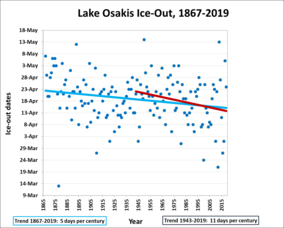
Minnesota is experiencing changes. It's getting warmer and wetter, which has shortened lake ice season. For example, Lake Osakis - an average-sized lake in central Minnesota - experiences ice-out more than a week earlier now than it did in the 1940's (see graph to the left).
Average temperatures are rising around the globe, particularly in northern regions like Minnesota. Minnesota's winters are warming faster than any other season. We don't get as cold as often anymore (see graph below).
|

Weather versus climate - you may wonder, what's the difference? Annual weather patterns are variable. Some winters will be cold, still more will be mild. Weather is a snapshot in time, like a photograph from childhood. Climate is measured over decades, tracking changes over the course of a lifetime.
A shortened lake ice season has environmental and cultural effects for Minnesota:
* A longer open water season, in combination with increased stormwater runoff and erosion caused by heavier rain, means that many bodies of water will experience more algae blooms.
* Warming surface waters are leading to a loss of fish habitat for many prominent species, including trout and walleye.
* Shortened and unpredictable ice cover results in condensed ice-fishing seasons.
We need more data on lakes all across the state to better understand how the ice cover season is changing. The State of Minnesota began collecting lake ice data from citizens in the 1970's and is always looking for more volunteers. The larger the data sets available to researchers, the better we can understand the effects that changing ice cover has on lake health, local wildlife and citizen lake use. Become a lake ice reporter today!
Back to top
|

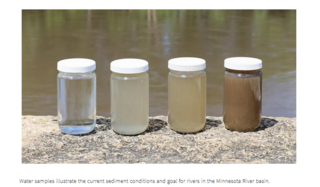
The Minnesota River Basin has many water quality challenges--from elevated nitrates, phosphorus, and sediment, to the sheer volume of water flowing to and from the river. Four studies released by the MPCA this summer point to changes in water and land management needed across the entire basin to improve its water quality.
This past spring, more than 100 people attended a Water Storage Forum at the Kato Ballroom in Mankato to learn about the need for water storage, and the methods used for implementing this water quality practice.
Don and Becky Waskosky, who live along the Le Sueur River south of Mankato, kicked off the forum by describing the severe bluff and bank erosion in their neighborhood. That erosion led them to get involved in the Le Sueur River Watershed Network. The network brings people of diverse backgrounds and needs together to work toward common goals. Along with the forum, a website was created to house information about the how, why, and what we can do to help restore hydrology and improve water quality: https://mrbdc.mnsu.edu/water-storage
Back to top
|

By Beth LaVigne, Citizen Stream Monitor on Tischer Creek, Duluth
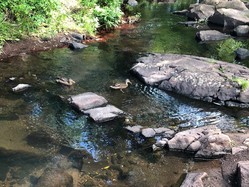
After doing water monitoring on Tischer Creek in Duluth for several years I came across an article written by Christine Anne Royce in the National Science Teaching Journal Science and Children. The article, Becoming A Citizen Scientist*, motivated me to introduce the practice to my students. I teach science methods courses to future elementary and secondary teachers at The College of Saint Scholastica. These teacher candidates have the potential to inspire a multitude of citizen scientists! Royce’s article lays out a very manageable plan for teachers and their students to get involved in one or more citizen science efforts. With the help of the teacher, K-12 students gather information about projects that interest them. They answer the following questions:
- The question/purpose of this project is:
- Scientists need people to do the following to help with the project:
- What time of the year do they need data collected?
- What type of data would we collect?
- Can students help with this project? What are the grade levels or ages the scientists suggest can help with this project?
- Why we want to help with this Citizen Science project?
Classes can then decide which project(s) they would like to participate in.
The MPCA’s water monitoring is a great choice. It is place-based (near the student’s home/school), all materials are provided by the MPCA, all ages can participate, students’ families can “adopt” their own monitoring site, water quality issues can facilitate integration of subjects (math, social studies, etc). In this way water monitoring may serve as a sort of “gateway” for people to become more informed about and involved in environmental issues and realize the positive impact they can make as a citizen scientist.
*Royce, C. A. (2017, Summer). Becoming a citizen scientist. Science and Children, 22-27
Back to top
|
|
|